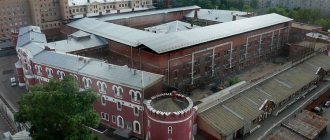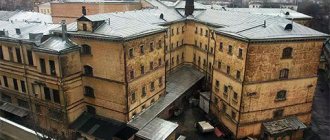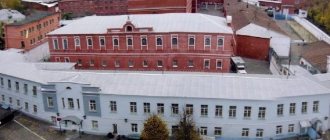The Federal Penitentiary Service (FSIN) of Russia has decided to close Butyrka, the largest investigative prison in Moscow, one of the oldest and most famous in the country. Over its more than two-century history, fighters against tsarism, Bolshevism, and victims of Stalin’s repressions managed to visit there. In the tower, where the leader of the peasant revolt, Emelyan Pugachev, once languished, mass executions of enemies of the people were carried out, and in the dashing 90s, criminal authorities feasted there. The main prison of Moscow has survived two empires and, it seems, has seen everything. The history of the legendary Butyrka was remembered by Lenta.ru.
“Instruments of torture were taken from Hitler’s Germany”
After the political events of 1905, a new part of the history of Butyrka prison began. The cells turned out to be filled to capacity with fighters against tsarism, and the rules of detention were tightened so much that the prison turned into a real hell. The prisoners were beaten daily, and those who were dissatisfied were immediately sent to punishment cells. A number of “status” prisoners visited the dungeons of “Butyrka” at the beginning of the 20th century - from the sailors of the mutinous cruiser “Ochakov” to the poet Vladimir Mayakovsky. In 1908, for the amusement of exhausted prisoners in Butyrka prison, the legendary illusionist Harry Houdini conducted an experiment: shackled, he managed to free himself from a special transport box in which prisoners were transported to Siberia in 28 minutes.
The Bolsheviks, who came to power during the October Revolution of 1917, first of all released political prisoners from Butyrka and began to use it as an investigative prison - essentially, a pre-trial detention center. The years of Stalin's rule were perhaps the darkest time in the history of Butyrka: it turned out to be terribly overcrowded. Instead of 3.5 thousand prisoners, it simultaneously held about 20 thousand prisoners, most of whom were shot at the end of the investigation.
Butyrka prison inside. 1937
Photo: archive of the Memorial Society
According to some reports, death sentences were carried out directly in the Pugachev Tower. Only executioners, a prosecutor, a doctor and the head of the prison worked there, and therefore everything that happened in the tower remained a secret. There were rumors that the convict was launched into a narrow corridor, and, having previously measured his height, they shot him in the back of the head... After the execution of the prisoner, his family received only short news that their loved one was no longer alive.
In the 30-40s of the 20th century, up to 170 prisoners could be kept in the cells of the Butyrka prison, designed for 25-30 people. Journalist Evgenia Ginzburg in her book “Steep Route” describes in sufficient detail her life in Butyrka at that time:
“An entire wing of some floor, probably equipped with the latest executioner technology, was reserved for night interrogations at Butyrka. At least, Clara, who visited the Gestapo, assured that the instruments of torture were certainly taken from Hitler’s Germany.”
Butyrka Prison Museum
Museum in Butyrskaya prison
In 1971, a museum was opened in Butyrskaya prison, on the 3rd floor of the Pugachev Tower. Previously, only employees of the establishment could visit it, but now excursions are offered here. However, to get there, you will have to undergo strict control and inspection.
And now you find yourself in the oppressive atmosphere of the Pugachev Tower. You look around, but don’t see the entrance to the museum anywhere. It turns out that he is hiding behind a bookcase. Enter it, go down into the dungeon, pass by a mannequin in the form of a warden - and now you are in the museum.
Here you can see the whole history of Butyrka prison. Paintings depicting prison life; photos of former “guests”; things the prisoners made with their own hands while sitting in their cells - maps, models of sailing ships, sharpening tools, tools for tattooing. Particularly worth highlighting is the exhibition of things that prisoners swallowed in order to end up in a hospital ward from their cell. One cannot ignore the so-called aggravating objects (which make the prisoners’ existence more difficult): shackles and an iron spear, which did not allow the prisoner to sleep; A 25-kilogram “anti-escape” chair to which the prisoner was attached and he carried it everywhere.
In the museum you can also see things made by prisoners in the workshops.
Elena Karpukhina, gymnast
Interesting fact. The museum guide shows the Singer sewing machine, which the fashion designers kept in Butyrka sewed clothes on. They say that among them there were very talented and famous people, the things they sewed were even supplied to the Kremlin.
And in the Butyrka prison museum there is an exhibition dedicated to Elena Karpukhina, a multiple winner of world championships in rhythmic gymnastics.
Elena Karpukhina was born in 1951 in Butyrka (her mother was imprisoned here) and spent the first two years of her life here. At the age of 16, the girl became the world champion.
Elena Karpukhina donated all her medals and cups to the museum. She takes an active part in all events of the Butyrka prison, meets with prisoners, and is a member of the board of trustees.
Moscow "Shawshank"
Little is known about what happened in the dungeons of the Butyrka prison from the early 50s to the late 80s. The bloody legacy of the Stalin era gradually faded away, but the gloomy image of this place has not gone away. There was even a belief among the prisoners: whoever escapes from Butyrka will definitely return there. At least that's how it was in the Soviet years. But in the dashing 90s, prisoners began to escape from the main prison in Moscow one by one.
There is even an urban legend about underground tunnels under Butyrka, through which two fugitives were released in 1993 near the Savelovskaya metro station - however, it has never received official confirmation. But three years later, in 1996, two Butyrka prisoners actually managed to escape: they peeled back the bars in the exercise yard and descended through the roof using a rope to the street. A few years later, three especially dangerous criminals disappeared from Butyrka: they dug through the cracked cement floor with spoons and escaped through the sewer. Soon another prisoner repeated their “feat”: he got out of the cell by squeezing out the bars on the window.
Butyrskaya prison building. 1993
Photo: Yuri Tutov / RIA Novosti
However, all the fugitives were eventually caught and returned - with one exception. The only one who successfully escaped from a pre-trial detention center in 2010 was the 26-year-old Belarusian parkour champion Vitaly Ostrovsky, who was serving a sentence for a series of thefts. According to eyewitnesses, he pushed the guard and by some miracle jumped over a five-meter-high wall with barbed wire. He was caught only two years later - in Finland.
In the history of Butyrka there are generally enough bright episodes. So, in May 1994, thief in law Sergei Lipchansky, nicknamed Sibiryak, organized a gathering of crime bosses right behind bars, which became famous as the “Butyrka banquet.” Having paid several guards 10 thousand dollars each, Sibiryak led about 30 people into his cell. True, the thieves’ “party” ended in tears: both its participants and the corrupt jailers were captured by RUBOP operatives.
On August 2, 1996, the last death sentence in Russia was carried out in Butyrka: the maniac Sergei Golovkin, nicknamed Fischer, who had 13 proven murders to his name, was executed there. Also in 1996, a decision was made to end the detention of women in the remand prison, with the exception of the psychiatric department of the prison hospital.
How I wanted to go to prison, but didn't
Photo from the Internet.
It is impossible to get there from the street. Interest in the museum must be supported by documentary evidence. My attempts to penetrate the museum are worthy of a separate story, which will be discussed further.
Three years ago, I asked the RSP secretariat to give me a letter of recommendation for Petrovka 38 to the Museum of Forensic Science. Then everything worked out. I ended up at Petrovka (I can’t write about this by agreement). Later he asked me to write another letter addressed to Butyrka’s boss. This was compiled. Moreover, the RSP secretariat sent it by mail.
The letter contained my contacts. Accordingly, I waited for them to call me. A month passes, I understand that something is wrong here. I called the boss’s secretary in Butyrka. She replies that they did not receive any letter.
Next, the woman advises sending the letter by fax. I come to the RSP secretariat, they give me a letter. I start rushing around offices looking for a fax. Nowadays, such a technique is a rarity. And yet I find the fax. On the third or fifth attempt, they answer from the other end that the letter has arrived.
I am again waiting for an invitation without receiving an answer. I consult with a man named Andrey (changed), who worked in a similar service. He replies that he will try to help get into a similar museum in Kresty.
St. Petersburg Crosses is a slightly different topic. I am more attracted to the history of Butyrka and its inmates, and not to the conditions of detention. And yet I agree. I appear again in the RSP and declare that it’s not working out with Butyrka, I ask you to give me another letter to Kresty.
Here an incomprehensible silence begins, and then the secretariat announces to me that we will no longer use this practice of letters of recommendation. I ask this way and that - the answer is a clear no. The old Russian rule applies here - no matter what happens. RSP chose to keep a low profile and not take risks.
At this moment, one knowledgeable person explains to me as an amateur that such issues are resolved not by mail, but by feet. He advises that I go to Butyrka myself and explain the situation. I attach the legs to the hopelessly outdated letter and go to the reception.
Everyone has pleasant moments in life that they want to share with others, and there are also those that they don’t want to talk about. What I want to tell you about did not bring me joy. On the contrary, such places in some way take away energy. Still, I think it’s worth telling.
The head of Butyrka receives visitors once a week. In order to get to the reception, people keep a list that is posted near the door. At the appointed time, the boss (both times I ended up with a deputy) enters the office and begins the reception. He sits in the same room with a lawyer. The people, for the most part, are rushing here and there.
90% of walkers are women. They are divided into wives and mothers. The latter make up the absolute majority, many cry, some have hysterics. Women come to Moscow to get an appointment, and there is a huge queue. The issue cannot be resolved quickly. Mothers, most of whom are pensioners, huddle at night in corners and train stations. Looking at them, listening to their conversations, you scratch your own soul.
(I remember in the 90s I talked with an investigator from Matrosskots Tishina. Everyone was showing off then. Leather jackets were in fashion. In turn, the investigator told me: “I look at all this cronyism and it makes me laugh. All these people get caught bulls come to me, they begin to pawn each other. Mothers beg tearfully for them. Sometimes I myself feel sorry for them, even though I have to imprison them."
A lawyer can help you obtain permission to install a refrigerator or TV in your cell. His line is moving faster. The boss solves more complex issues, and therefore one visitor can hang out with him for an entire hour.
I was surprised to learn that the relatives did not bring the TV and refrigerator here themselves. Equipment can be ordered for delivery from the store.
Walkers with groceries are constantly scurrying through the hall where visitors are waiting their turn to be received. There is another hall nearby where transmissions are received. The weight limit rule applies here. I saw two Caucasians bring a large box with the freshest tomatoes and a whole bag of rolls and sausages. Then indignant voices were heard. The transfer was terminated. The guys managed to write something off to the sidekick, while they took a significant part of the food back.
Women of retirement age carry more modest transfers. Residents, like ordinary citizens, are divided into rich and poor.
The closer the time for the end of the reception approaches, the more the tension increases. The first time, realizing that I was running out of time, I left and signed up for the next week. The second time the situation was about the same. The only thing is that the list with the queue disappeared somewhere; those who came earlier wanted to start the queue from scratch. They were not allowed to do this; many of them had their old list photographed on their phones. In a word, everything here is like in the old Soviet times, or almost everything.
To whom is war, and to whom is mother - a proverb that is relevant for any time. A special segment of visitors are lawyers and all kinds of jurists. They are distinguished by their confident behavior, fancy iPhones, mandatory briefcases and expensive clothes.
Nimble as monkeys, these guys and girls scurry back and forth, waiting for a pass. They do not contact petitioners. The first and second, although they form a single river, at the same time remain completely different flows, in which different laws of physics and universal gravitation operate.
Straining my ears, I overheard the sleek lawyer explaining to his colleague:
“I tell him, I’ll try to bring it in, but I’m not sure... The most important thing, tell me, I didn’t see this, I was just standing next to it - you’ll go under a different article. What's the point, he waved them off anyway... So I'm telling you, it's unknown how things will turn out at the trial. No later, the entire amount must be taken at once...”
I was also surprised by the strong, athletic-looking guys. I thought, the guys, not embarrassed by anyone or anything, talking about something with the employees of the detention center, are solving their own issues. No, strong gangster-looking guys turned out to be investigators and interrogators. As they say, whoever you mess with, you'll gain from.
The second time I didn’t get an appointment again. There seemed to be a line, but it didn’t promise to reach me. One of the employees, seeing that I was not an ordinary person for this place, asked what I wanted from the boss? Having heard the answer, she explained that people go to the museum, but the head of Butyrka does not deal with such issues. Permission to visit is issued by the general.
It turns out I was hitting the wrong wall. My letter was formatted incorrectly. In this fuss they simply threw him aside, not considering it necessary to answer. Everything is logical, vanity reigns here, mixed with tearful requests. There is a ton of things to do, a ton of questions - they need to be resolved, but here I am with my nonsense...
The ensign radiated confidence that was passed on to me. Having looked at the address and reception hours, the next week I went to Narvskaya Street, where another pre-trial detention center is located. Having called the secretariat from the checkpoint, I outlined the essence of the issue and made an appointment with the general. Surprisingly, they issued a pass to me.
While I was hanging around at the checkpoint, an employee came out through the turntable and asked me if I was Egorov, who came to serve time after the verdict was passed? This is how you can easily get inside a pre-trial detention center without doing anything!!!…
By the appointed time, a small crowd had gathered, again consisting of women. After reading out the list, the guard let us into the territory one by one.
I was the last to be invited into the office. Next to the general sat a human rights activist who recorded citizens' appeals. The general himself, although a year younger than me, looked very respectable, which made me even a little nervous. After some time, he was supposed to hold a meeting with his employees, but he listened to me carefully, asking what exactly and what topic I wanted to know.
I replied that I was interested in Nestor Makhno. Where and how did he sit? Under what circumstances did he have his lung removed in Butyrka?
(This really interests me. In order to visit Makhno’s former capital Gulyaipole, I specially went to Ukraine. For those interested, I suggest you look at the stories:
Gulyaypole: literary (Walking through torment) and the present
Gulyai-Polye Museum of Local Lore)
The general promised to let me into the museum, asking me to write a new letter.
This is what is called the finish. The circle is closed! They can show me the prison museum if there is a letter, which the RSP no longer wants to give. I wrote and called them again, but to no avail.
One conclusion can be drawn from all this: in Russia, just like 100, just like 200 years ago, the basic rule of life is not to allow or let in, because - what if!
L.N. Tolstoy, while working on the novel “Resurrection,” in January 1899 visited the warden of Butyrka prison I.M. Vinogradov and asked about the details of prison life. In April 1899, he came to the transit prison to walk with the prisoners on the way to the Nikolaevsky (Leningrad) station, and then depicted this path in the novel.
In those distant years everything was simpler. In the present there are countries where you can go to prison. Moreover, schoolchildren are taken there on excursions so that they do not commit offenses in the future.
I remember in Soviet times there were signs everywhere: don’t walk on the lawns, don’t swim in the fountain. Accordingly, as a legacy of the dark past, paratroopers fought with riot police every year on Airborne Forces Day. The police were given the task of not letting the paratroopers into the fountain.
And suddenly one year they were allowed to swim. The guys climbed into the fountain in Gorky Park and began splashing around. Nothing terrible happened after that, the sky did not fall to the ground and all Moscow buildings survived.
The question arises: why did the police bother with legalized nonsense for so many years? And now everything is different with lawns: walk on the grass, choose a place, lie down where you want and relax.
I am a citizen of Russia, I have never been under investigation and have never been charged with any charges. Paying off my debt to my Motherland, I served in the army for two years. The question is, why can’t I get to the Butyrka prison museum? Moreover, I could write a short story that could theoretically stop someone from committing a crime.
According to Andrey, some time ago the Crosses could be visited by signing up for a tour. Then some important official arrived and made a remark - The pre-trial detention center has no right to take money. Excursions to the prison museum have been closed. Now you won’t get there, but everything is according to the law.
* * *
So, if I can’t get inside, no one forbids me to take a walk around the Butyrka prison.
Prison range
Despite the fact that in the 21st century the truly terrible times in the history of Butyrka are a thing of the past, the conditions of detention for prisoners there still leave much to be desired. In 2008, arrested businessman Alexei Kozlov, in collaboration with his wife, journalist Olga Romanova (now the founder of the Sitting Rus' movement), began publishing his prison diaries on the Internet under the name “Butyrka Blog”.
“The fact that it is very cold in the cell does not make any impression on anyone. There are no questions about where we store the products that relatives give us. No one asks how we dry things, or how we manage to open a window that doesn’t have a single handle,” Kozlov wrote about the conditions in the pre-trial detention center.
Butyrsky pre-trial detention center (top view)
Photo: Anton Denisov / RIA Novosti
In a conversation with Lenta.ru, human rights activist Vladimir Osechkin says that Butyrka, built in tsarist times, despite its historical value, has long been absolutely unsuitable for holding prisoners.
“In the detention center, basic sanitary standards are not observed to ensure a normal standard of living for prisoners - no amount of cosmetic repairs will save you from this,” he says. — In most cells there is no hot water, normal heating, a latrine, especially in large cells, one for 10-40 prisoners. Many people there become seriously ill.
However, despite such terrible conditions, the jailers, according to Osechkin, tried out more than one know-how in Butyrka in their own interests. In particular, it was the main pre-trial detention center in Moscow that became the place where they first began to use jammers and the latest electronic systems to block prisoners’ mobile communications.
Temple of Butyrka Prison
Temple in Butyrka Prison
As we wrote above, the Intercession Church was originally built in the center of Butyrka. But after the revolution of 1917, it suffered the fate of other churches in Russia - church utensils and silver were looted, workshops were first placed in the church building, and in 1922 it was completely closed.
In the thirties of the 20th century, the premises of the temple became a refuge for prisoners awaiting transport to Siberia. It was here, in particular, that Solzhenitsyn had to sit for some time. And according to him, the conditions in the cells of the temple were terrible, much worse than in the cells of the main buildings of Butyrka prison.
Also here were former high church ministers who were outlaws for the Soviet regime.
Decades later, the temple housed a prison hospital.
In the 90s of the last century the situation began to change. First, the priest began to come to the Butyrka Church, then in the former church he was given a corner where he began to conduct services. A few years later, a long renovation of the temple began, and in October 2004, on the day of the Intercession of the Most Holy Theotokos, the first service was held here.
Prayer room for Muslims
But it’s not only Christians who are in Butyrka prison. For example, usually a third of Butyrka prisoners are Muslims, so some time ago a prayer room was equipped for them in the Butyrka prison.
And for adherents of Judaism, a synagogue was opened in one of the cells.
For prisoners of any religion, getting to a holy place is not easy. First you need to write an application and wait a long time for your turn, since there are always a lot of people who want to pray, and the premises cannot accommodate a large number of worshipers. In addition, prison officials must compile lists of those wishing to pray so that people who should not meet, for example, former accomplices, do not meet in the temple.
According to the priests and the imam, the prisoners strive to get to the Church of the Intercession, the Muslim chapel and the synagogue, because they acutely feel their guilt and want to make amends for it both before people and before the Almighty.
Fall of Butyrka Castle
On December 16, the deputy head of the Federal Penitentiary Service (FSIN) of Russia, Valery Maksimenko, said that the Butyrsky pre-trial detention center (like pre-trial detention center No. 3 “Presnya”) had been decided to be closed. Moreover, earlier the FSIN planned to close only “Presnya” - but the Moscow mayor’s office came up with a proposal to close also “Butyrka” along with “Matrosskaya Tishina” (the fate of this pre-trial detention center has not yet been decided).
Instead of three detention centers, officials proposed building one new one at the city’s expense for five thousand prisoners. The exact location for the future pre-trial detention center has not yet been determined. According to Maksimenko, the Federal Penitentiary Service is considering two areas - on Kaluzhskoye Highway in New Moscow and a site on Dmitrovskoye Highway. The desire of the prison guards to build a new detention center as far as possible from the center of the capital is quite understandable: “Butyrka” is located in close proximity to residential buildings, and residents of the Butyrsky district often write complaints to various authorities about screams, the noise of sirens, howling dogs and unpleasant odors.
However, speaking about the construction of a new detention center in Moscow, it is worth remembering the sad experience of constructing the Kresty-2 pre-trial detention center in St. Petersburg, which was accompanied by numerous corruption scandals. And after the launch of the newest St. Petersburg detention center, it turned out that the conditions of detention there were far from ideal.
“It’s no secret that the Kresty-2 isolation ward functions poorly,” says Vladimir Osechkin. “Many cells were not ready for the prisoners to move, so we regularly receive complaints from prisoners. I think this is due to the fact that Russia has no experience in managing large prison complexes housing several thousand prisoners.
Interesting facts about Butyrka prison
Mickey Rourke in Butyrka
Once upon a time, American actor Mickey Rourke found himself in Butyrka. He was not her prisoner, but simply visited on a tour. The prison authorities showed Rourke the cells, the museum, the temple and outbuildings. The actor talked with the prisoners and gave them his autograph, and the head of the colony gave him a prison uniform as a farewell gift. Why did Mickey Rourke need this? For some role in a movie. What was his impression? According to Mickey, conditions in Butyrka prison are much better than in American prisons.
On March 18, 1984, during a concert, singer Zhanna Aguzarova was detained and placed in Butyrka, where she spent some time. The reason for the arrest was that she had a passport in someone else’s name.
Some scenes of the cult Soviet series “Seventeen Moments of Spring” were filmed in Butyrka prison, in particular, the dungeons of the fascist Gestapo.
Group "Butyrka"
In 2001, the Russian musical group “Butyrka” was organized and exists to this day. Why did never-sat musicians with a clean biography choose such a name for their band? According to them, they were strongly impressed by the 2001 prison escapes, which we described above, which is why they called themselves the Butyrka group.
As we have already mentioned, many Muscovites do not like the fact that in the center of the capital, among residential buildings, there is the Butyrka prison. And many advocated for its transfer to another place. It looks like their dream will soon come true. Finally, a decision was made to move it to the Moscow region, but its building will not be demolished. We remind you that this is an architectural monument under state protection. Time will tell what they will do with it.
Old Melbourne Gaol
This prison in Australia was built in 1841 and closed in 1924. Part of the building was dismantled. During the Second World War it was used as a military prison, later as police storage, and in 1972 the Old Melbourne Gaol was opened as a museum. Thousands of tourists visit it every year. This impressive building in the city center offers a variety of tours. For those who like to tickle their nerves, we recommend signing up for the night excursion “Ghosts of Prison” or “Life of an Executioner”.
The cost of visiting is 2500 rubles.
Prison in Karosta
The only military prison in Europe open to tourists, from which no one has ever escaped, is located in Latvia. The building, built in 1990, was originally the military port of Liepaja. The prison was intended to imprison violators of military discipline. Now anyone can go on a tour of the mysterious colony. According to the organizers, at night you can see ghosts and get lost without a guide. There are several scenarios for tourists: from the “Labyrinth of Sensations” excursion to overnight imprisonment behind bars.
The cost of visiting is from 2500 rubles.








